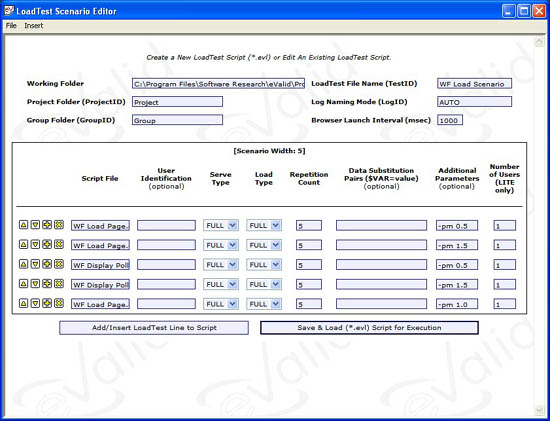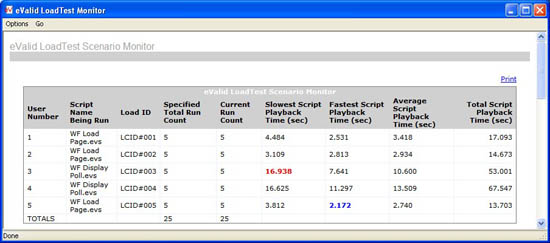|
Software Development Magazine - Project Management, Programming, Software Testing |
|
Scrum Expert - Articles, tools, videos, news and other resources on Agile, Scrum and Kanban |
Click here to view the complete list of tools reviews
This article was originally published in the Summer 2010 issue of Methods & Tools
eValid
Franco Martinig, Martinig & Associates, http://www.martinig.ch/
eValid, is a testing tool suite built into an IE browser. eValid performs every function needed for detailed Web Site static and dynamic testing, regression testing, QA/Validation, page timing and tuning, transaction monitoring, and realistic & scalable server loading
Web Site: http://www.e-valid.com
Version Tested: eValid V9 Build 301, tested during May-June 2010 on Windows XP Home Edition SP3
System Requirements: eValid V9 relies on certain properties of the IE DLLs that are only available in IE Ver. 5.50 and later versions until IE 9.0. Similarly, certain features of the technology require use of Windows operating system features that are only present in Windows 2000/SP4, Windows XP, Windows Vista, Windows 7 and Windows Server 2008. At launch eValid will provide an advisory notice (popup) in case the minimum required operating capabilities are not present.
License & Pricing: Commercial, prices are visible http://www.e-valid.com/Products/bundle.pricelist.9.html
Support: User mailing list, forum and blog
Installation
The installation runs smoothly through an InstallShield process. After registering the license key(s) (Help/Manage License), you can start working with the product.
Documentation
The documentation (user manuals, tutorials, movies, demos, etc) is comprehensive and fully accessible from the tool. To have a first glance
at the tool features, I will recommend looking at these online resources:
Tutorials: http://www.e-valid.com/Products/Training.9/index.html
Videos: http://www.e-valid.com/Products/Documentation.9/Movies/inventory.html
Configuration
eValid as a "Settings" panel that allows to modify general options and also settings that are particular to a specific feature (record, playback, site analysis).The user manual gives a detailed explanation of each configuration field. The default configuration allows working well, but there are many parameters that could change your assessment of the results, especially in the site analysis area.
Features
Architecturally, eValid is an "overload" of the IE browser. It adds functions to the browser by incorporating the entire browser as a support engine.
* Functional Testing
You can create a script simply recording your actions on the web page and adding validation action that are proposed by the tool. By default the settings are for "real time" recording, which means that the "wait" time between two actions will be automatically recorded by the tool. This can be changed in the settings. An existing script can be modified, inserting new actions at a particular point. The recorded script can be also manually edited, which allow to remove certain items, modified input, waiting times and validations parameters. Validations can be made at the document level (title, byte size, last modified date), on a page element (text, image, table cell) or on a page area. In fact the tool can validate and synchronize any DOM property anywhere on the current page.

Figure 1. Functional test script created through navigation with element validation
"Point and click" is the first and simple way to create functional tests with eValid, but the tool support "structural/algorithmic" testing and full programmatic testing. Thus eValid can automatically synchronize with AJAX applications using the built-in DOM (Document Object Model) interrogation capability. You can also parameterize scripts, manage control flow as they execute. Data from external files can be fed into scripts.
* Load Testing
The load testing function in eValid uses the same script repository than the functional testing part. You can therefore either reuse an existing script or create a dedicated item for load testing. You can specify the number of times that you want to run the script and the delay between each run. This playback multiplier allows increasing or decreasing the speed or repetition. The functional scripts and this additional information allow you to create load-testing scripts. The estimated number of users is dependent of these parameters. A script repeated 5 times that is complete in 20% of the normal time is the equivalent of a 25 users load. The load script runs each functional script in a separate eValid sub-browser without cache to assure that each page is actually downloaded. Information used for the test (like user names) can be changed for each test. You can obtain 100 Browser Users (BUs) per desktop session and eValid is able to run over 1,000 using multiple desktop sessions on a single machine.
My test scenario runs twice a test that just loads the home page, then twice a test that goes to a poll page, displays results and verifies the presence of a text on the result page, then again once the load home page test.

Figure 2. Load testing scenario


Figure 3. Load testing results
* Web Site Analysis
You can launch the web site analysis either in automatic or controlled (interactive) mode. Many setting screens that allow you to control the analysis (depth of pages, links to follow or exclude, etc), manage the degree of analysis and your own definition for of what is an old, large or small page. It took to the tools, 30 minutes to analyze automatically the complete Methods & Tools web site with the default analysis settings. For a simple web site like waterfallalliance.org, it takes 20 seconds. A 3D-SiteMap shows inter-relationships of all scanned pages. Reports are generated in real time.
* Additional Functions
The eValid suite contains a dedicated test suite management engine. This system organizes a suite of eValid tests into groups and complete projects when you locate test scripts in the same folder. It launches and analyzes eValid test results and provides a compact PASS/FAIL report summary. You can use eValid as an AJAX monitoring agent with its synchronization capabilities.
eValid offers also a test data generator. All test results are usually stored in text files, but you can also use a MySQL access to store them. The tool proposes also a batch interface (command line operation) and an available C++ interfacer.
Conclusion
eValid is a software testing tool suite that allows testing both the functionality and the performance of a web site. You can also do a site analysis. The tool is quite intuitive and the training level needed for a first usage not important, watching the short movies available that explain the basic functions. This allows people without technical experience to build and run their own tests. It is nevertheless a powerful tool that goes far beyond a simple "point and click" technology and you can spend time adjusting the settings and the scripts to your technical needs for more sophisticated testing, especially for AJAX applications.
Related Resources
- Software Testing Magazine
- Functional Testing Tools Directory
- Software Testing and Quality Portal
- Software Quality Assurance Blogs
- Software Testing Tutorials and Videos
|
Methods & Tools Testmatick.com Software Testing Magazine The Scrum Expert |



